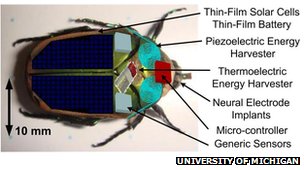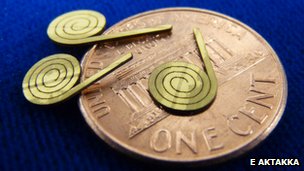Cyborg search-and-rescue insects' power source unveiled
 The research team proposed putting two spiral energy harvesters on either side of a beetle's thorax
The research team proposed putting two spiral energy harvesters on either side of a beetle's thorax
Efforts to create an army of cyborg insects are being pursued by a team of US-based engineers.
The group is investigating ways to harvest energy from the creatures to power sensors and other equipment fastened to their bodies.
The team has created an energy scavenging device that is attached close to the insects' wings.
It suggested the creatures might one day be used to aid search-and-rescue operations and surveillance.
The University of Michigan team of engineers published their study in the Journal of Micromechanics and Microengineering.
Power sourceThe report noted that, despite major advances in micro-air-vehicle technology, no-one had been able to match the aerodynamic performance and manoeuvring capability of insects.
However, it said that if insects were to be equipped with control mechanisms and other add-on kit, the equipment would require a power source.
The team rejected the idea of using miniature solar panels because they would be dependent on available light. So the group decided to develop a vibration energy collector.
The resulting device consists of a tiny three-layered spiral generator.
The outer two layers are made up of PZT-5H - a ceramic substance that produces an electrical charge when mechanical stress is applied. An inner layer of brass provides reinforcement.
Muscle powerThe researchers used Green June Beetles to determine the best place to locate the device.
They identified the wings as the most promising power source.
However, the creatures' wing membranes were not rigid or strong enough to support the device, and it also made them less aerodynamic. So the team focused, instead, on the animals' wing muscle.
The engineers ultimately decided to attach two of the spiral beams to each beetle's thorax. The end of each coil extended out to touch a hardened part of the insect's body close to its wing base where it could pick up energy.
The two devices weighed less than 0.2 grams and generated 45 microwatts of power during flight.
 The energy harvesting spiral beams are small enough that two can be fitted to each beetle
The energy harvesting spiral beams are small enough that two can be fitted to each beetle
The researchers suggested that the devices could eventually become the power source for a race of remote controlled cyborg insects with neural electrodes implants, communications equipment, microphones and other sensors.
The team suggested the creatures could wear the equipment in tiny "backpacks".
The animals could then be released into dangerous or hard-to-access locations after an accident has occurred. The information they gathered could be beamed back to the emergency services to help prepare a response.
They said the creatures could usher in "a new era for search-and-rescue operations, surveillance, monitoring of hazardous substances, and detection of explosives".
This is not the first time researchers have tried to work out how to turn animals into remote-controlled automatons.
The report's authors noted experiments to control rats through the parts of their brains related to their whiskers, an attempt to direct sharks by stimulating the part of their brain linked to their sense of smell and research into the locomotion control of cockroaches.
The team also noted that a previous attempt to harvest vibration energy from moths had failed because the 1.28g weight of the device involved proved too heavy for the insects to carry.


 Yahoo prodigy faces big decision
Yahoo prodigy faces big decision Pistorius awaits homicide verdict
Pistorius awaits homicide verdict Bonsai computing
Bonsai computing 7 days quiz
7 days quiz Words from the water
Words from the water Rastas in Africa
Rastas in Africa Expialidocious
Expialidocious